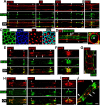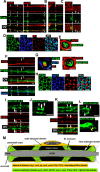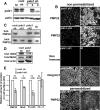Pals1 is a major regulator of the epithelial-like polarization and the extension of the myelin sheath in peripheral nerves
- PMID: 20237282
- PMCID: PMC6632289
- DOI: 10.1523/JNEUROSCI.5185-09.2010
Pals1 is a major regulator of the epithelial-like polarization and the extension of the myelin sheath in peripheral nerves
Abstract
Diameter, organization, and length of the myelin sheath are important determinants of the nerve conduction velocity, but the basic molecular mechanisms that control these parameters are only partially understood. Cell polarization is an essential feature of differentiated cells, and relies on a set of evolutionarily conserved cell polarity proteins. We investigated the molecular nature of myelin sheath polarization in connection with the functional role of the cell polarity protein pals1 (Protein Associated with Lin Seven 1) during peripheral nerve myelin sheath extension. We found that, in regard to epithelial polarity, the Schwann cell outer abaxonal domain represents a basolateral-like domain, while the inner adaxonal domain and Schmidt-Lanterman incisures form an apical-like domain. Silencing of pals1 in myelinating Schwann cells in vivo resulted in a severe reduction of myelin sheath thickness and length. Except for some infoldings, the structure of compact myelin was not fundamentally affected, but cells produced less myelin turns. In addition, pals1 is required for the normal polarized localization of the vesicular markers sec8 and syntaxin4, and for the distribution of E-cadherin and myelin proteins PMP22 and MAG at the plasma membrane. Our data show that the polarity protein pals1 plays an essential role in the radial and longitudinal extension of the myelin sheath, likely involving a functional role in membrane protein trafficking. We conclude that regulation of epithelial-like polarization is a critical determinant of myelin sheath structure and function.
Figures









Similar articles
-
The Polarity Protein Pals1 Regulates Radial Sorting of Axons.J Neurosci. 2015 Jul 22;35(29):10474-84. doi: 10.1523/JNEUROSCI.1593-15.2015. J Neurosci. 2015. PMID: 26203142 Free PMC article.
-
Altered molecular architecture of peripheral nerves in mice lacking the peripheral myelin protein 22 or connexin32.J Neurosci Res. 1999 Dec 1;58(5):612-23. doi: 10.1002/(sici)1097-4547(19991201)58:5<612::aid-jnr2>3.0.co;2-x. J Neurosci Res. 1999. PMID: 10561689
-
VE-cadherin interacts with cell polarity protein Pals1 to regulate vascular lumen formation.Mol Biol Cell. 2016 Sep 15;27(18):2811-21. doi: 10.1091/mbc.E16-02-0127. Epub 2016 Jul 27. Mol Biol Cell. 2016. PMID: 27466317 Free PMC article.
-
Myelinating Schwann Cell Polarity and Mechanically-Driven Myelin Sheath Elongation.Front Cell Neurosci. 2018 Jan 5;11:414. doi: 10.3389/fncel.2017.00414. eCollection 2017. Front Cell Neurosci. 2018. PMID: 29354031 Free PMC article. Review.
-
Microscopic anatomy: normal structure.Handb Clin Neurol. 2013;115:7-27. doi: 10.1016/B978-0-444-52902-2.00002-3. Handb Clin Neurol. 2013. PMID: 23931772 Review.
Cited by
-
PLEKHG5 deficiency leads to an intermediate form of autosomal-recessive Charcot-Marie-Tooth disease.Hum Mol Genet. 2013 Oct 15;22(20):4224-32. doi: 10.1093/hmg/ddt274. Epub 2013 Jun 17. Hum Mol Genet. 2013. PMID: 23777631 Free PMC article.
-
Traumatic and Diabetic Schwann Cell Demyelination Is Triggered by a Transient Mitochondrial Calcium Release through Voltage Dependent Anion Channel 1.Biomedicines. 2022 Jun 19;10(6):1447. doi: 10.3390/biomedicines10061447. Biomedicines. 2022. PMID: 35740468 Free PMC article.
-
SIRT6 inhibition delays peripheral nerve recovery by suppressing migration, phagocytosis and M2-polarization of macrophages.Cell Biosci. 2021 Dec 14;11(1):210. doi: 10.1186/s13578-021-00725-y. Cell Biosci. 2021. PMID: 34906231 Free PMC article.
-
C. elegans MAGU-2/Mpp5 homolog regulates epidermal phagocytosis and synapse density.J Neurogenet. 2020 Sep-Dec;34(3-4):298-306. doi: 10.1080/01677063.2020.1726915. Epub 2020 May 4. J Neurogenet. 2020. PMID: 32366143 Free PMC article.
-
Genetic deletion of Cadm4 results in myelin abnormalities resembling Charcot-Marie-Tooth neuropathy.J Neurosci. 2013 Jul 3;33(27):10950-61. doi: 10.1523/JNEUROSCI.0571-13.2013. J Neurosci. 2013. PMID: 23825401 Free PMC article.
References
-
- Anitei M, Ifrim M, Ewart MA, Cowan AE, Carson JH, Bansal R, Pfeiffer SE. A role for Sec8 in oligodendrocyte morphological differentiation. J Cell Sci. 2006;119:807–818. - PubMed
-
- Carracedo A, Pandolfi PP. The PTEN-PI3K pathway: of feedbacks and cross-talks. Oncogene. 2008;27:5527–5541. - PubMed
-
- Chan JR, Jolicoeur C, Yamauchi J, Elliott J, Fawcett JP, Ng BK, Cayouette M. The polarity protein Par-3 directly interacts with p75NTR to regulate myelination. Science. 2006;314:832–836. - PubMed
Publication types
MeSH terms
Substances
LinkOut - more resources
Full Text Sources
Other Literature Sources
Molecular Biology Databases
Research Materials
